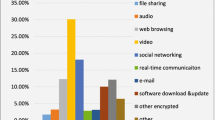Abstract
In IEEE 802.11 systems, the system throughput performance can be enhanced by optimizing the back-off window size based on the number of competing terminals n. Therefore, the information of n is crucial factor for optimal throughput performance in this system. However, estimating n is not an easy task because n varies with unknown statistical patterns. Most of previously proposed approaches additionally adopt a state variation detector in the algorithm, which incurs latency in tracking n. Therefore, we propose cost-reference particle filtering (CRPF) approach which is applied without an additional state variation detector. Consequently, a critical flaw of the detector, i.e. latency which causes highly degraded throughput performance, can be avoided. The proposed method promptly tracks varying n without any latency; therefore, it is highly efficient in non-saturated network condition. By computer simulations, we justify that CRPF is a new state of the art-approach for the investigated problem in terms of the tracking performance.





Similar content being viewed by others
Notes
Although the derivation was based on the scenario of fixed number of n competing terminals and saturated networks, the derived equations are applied for non-saturated conditions and for varying n provided that the estimation target becomes the average number of competing stations (rather than the total number of stations in saturation conditions). Please see end of Sect. VI of [6] for details.
References
Wireless LAN medium access control (mac) and physical layer (phy) specifications. (1999).
Albano, M., Hadzic, S., & Rodriguez, J. (2013). Use of negative information in positioning and tracking algorithms. Telecommunication Systems, 53(3), 285–298.
Arulampalam, M. S., Maskell, S., Gordon, N., & Clapp, T. (2002). A tutorial on particle filters for online nonlinear/non-Gaussian Bayesian tracking. IEEE Transactions on Signal Processing, 50(2), 174–188.
Bianchi, G. (2000). Performance analysis of the IEEE 802.11 distributed coordination function. IEEE Journal of Selected Areas in Telecommunications, Wireless Series, 18(3), 535–547.
Bianchi, G., Fratta, L., & Oliveri, M. (1996). Performance evaluation and enhancement of the CSMA/CA MAC protocol for 802.11 wireless LANs. In Proceedings of PIMRC, 1996, (Vol. 2, pp. 392–396).
Bianchi, G., & Tinnirello, I. (2003). Kalman filter estimation of the number of competing terminals in an IEEE 802.11 network. In: Proceedings of Infocom 2003, (Vol. 2, pp. 844–852).
Bianchi, G., & Tinnirello, I. (2010). Interference estimation in IEEE 802.11 networks. IEEE Control Systems Magazine, 30(2), 30–43.
Chang, S., & Wu, H. (2009). Novel adaptive DCF protocol using the computationally-efficient optimization with the feedback network information for wireless Local-Area Networks. IEEE Transactions on Wireless Commnications, 8(6), 2827–2830.
Hwang, G., & Cho, D. (2006). Performance analysis on coexistence of EDCA and legacy DCF stations in IEEE 802.11 wireless LANs. IEEE Transactions on Wireless Commnications, 5(12), 3355–3359.
Iratni, A., Katebi, R., & Mostefai, M. (2012). On-line robust nonlinear state estimators for nonlinear bioprocess systems. Commnications in Nonlinear Science and Numerical Simulation, 17(4), 1739–1752.
Kalman, R. E. (1960). A new approach to linear filtering and prediction problems. Transactions of the ASME-Journal of Basic Engineering, 82(Series D), 35–45.
Kim, J., Serpedin, E., & Shin, D. (2008). Improved particle filtering-based estimation of the number of competing stations in IEEE 802.11 networks. IEEE Signal Processing Letters, 15, 87–90.
Lim, J., Kim, T., & Hong, D. (2013). Estimating the number of competing terminals without a state variation detector in wireless LAN. EURASIP Journal on Advances in Signal Processing, 2013(1), 1–9.
van der Merwe, R., & Wan, E. (2003). Gaussian mixture sigma-point particle filters for sequential probabilistic inference in dynamic state-space models. In: Proceedings of Int. Conf. Acoustics, Speech, and Signal Processing (ICASSP), (Vol. 6, pp. 701–704).
Miguez, J., Bugallo, M. F., & Djuric, P. M. (2004). A new class of particle filters for random dynamical systems with unknown statistics. EURASIP Journal of Applied Signal Process, 2004(15), 2287–2294.
Sanyal, D. K., Chattopadhyay, M., & Chattopadhyay, S. (2013). Recovering a game model from an optimal channel access scheme for WLANs. Telecommunication Systems, 52(2), 475–483.
Torkamani, S., & Butcher, E. A. (2013). Optimal estimation of parameters and states in stochastic time-varying systems with time delay. Commnications in Nonlinear Science and Numerical Simulation, 18(8), 2188–2201.
Vercauteren, T., Toledo, A. L., & Wang, X. (2006). Batch and sequential Bayesian estimators of the number of active terminals in an IEEE 802.11 network. IEEE Transactions on Signal Process, 55(2), 437–450.
Acknowledgments
This research was supported by “Basic Science Research Program through the National Research Foundation of Korea funded by the Ministry of Education (NRF-2011-0009255)” and “the MSIP (Ministry of Science, ICT & Future Planning), Korea in the ICT R&D Program 2014 (B0101-14-0171).”
Author information
Authors and Affiliations
Corresponding author
Rights and permissions
About this article
Cite this article
Lim, J., Kim, T. & Hong, D. Estimating the number of competing terminals by cost-reference particle filtering in non-saturated wireless-LAN. Telecommun Syst 62, 519–527 (2016). https://doi.org/10.1007/s11235-015-0091-9
Published:
Issue Date:
DOI: https://doi.org/10.1007/s11235-015-0091-9




